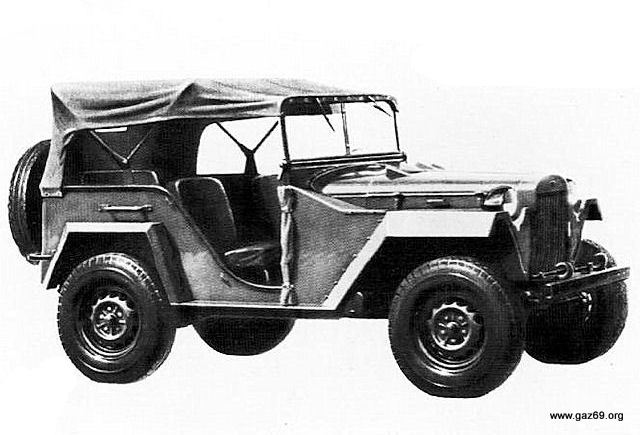
The history of the motor industry in Gorki began in 1932 with the licence to manufacture the Ford A. GAZ A was the first Russian built passenger car. Actually the very first units were called NAZ, because until 1932 the town was named Nizhnyj Novogrod. Within only four years of production they built 41.917 units. In 1935 the first home-built GAZ M-1 was introduced. From 1936 the factory carried the name of the then Russian prime minister W. M. Molotov. (Click on the name if you want to know more about his shameful achievements). In 1940 they developed a new version of the M-1: the GAZ 61-40 with four-wheel-drive and open four-door 'phaeton' body. Early 1941 saw the first Soviet 'jeep' – GAZ 64. A group of enthusiasts built the prototype literally within just two months. The production started in the summer that year. It looked very much like it's successor GAZ 67 (picture on the left), which came into the production in 1943. With it's 4-cylinder, 3.3 litre, 54 bhp engine and a weight of 1320 kg (26 cwt) the vehicle was well underpowered, however it remained in the production till 1953 and about 100.000 units were made. It was superseded by our main hero: the GAZ 69.
Please click this link to see whole history of the GAZ factory on my classic cars website.

Most
of the sources state the beginning of the GAZ 69 in 1954.
However, here, on the left is a picture that I found in Polish
magazine 'Motor' from December 1952.
Design of the GAZ 69
started in Gorki in 1946. Unlike it's predecessor the new truck
was designed slowly and carefully. By 1948 twelve prototypes
called 'Truzenik' were ready to be tested in various conditions
across USSR. Some of them covered over 100.000 km (62.000 miles).
Quite unusual by Russian standards those days. Unfortunately the
other new GAZ vehicles, the M-20 passenger car and the GAZ-51 and
GAZ-53 trucks took priority and the project was delayed. There were
some prototypes with differential locks, but they were considered
to be too complicated and haven't been approved for the
production.
The limited assembly began in 1952 and next
year, in July the GAZ 69 replaced the GAZ 67 on the assembly
lines.
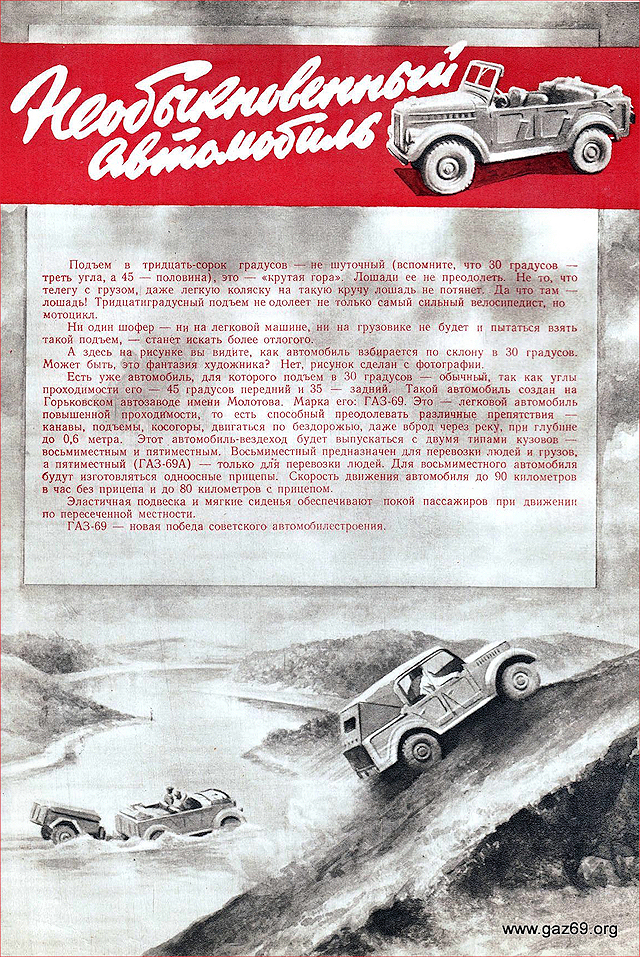
An article from a Russian magazine of 1953.
Direct translation:
A climb of thirty or forty degrees is not a joke (remember that 30 degrees - is a third corner, and 45 is a half). It is a "seriously steep hill." It can not be overcome by horses. Not with a cart loaded, even with light load horses would not pull on such steepness. Why are there - the horse! Thirty degrees rise could not be overcome even by the strongest cyclist, or motorcycle.
No driver - not in a car or truck will attempt to take such a rise - will seek a more sloping.
Here in the picture you can see how the car climbs the slope of 30 degrees. Maybe it's an artist fantasy? No, the image is made from a photograph.
There is a car for which the rise of 30 degrees - is normal, since the angles cross it - 45 degrees forward and 35 - back. This car is built upon the Gorky Automobile Plant named Molotov. Make it: GAZ-69. It - car raised passableness, that is, able to overcome various obstacles - ditches, slopes, hillsides, go on the road, even wade across the river, at a depth of 0.6 meters. This car - cross-country vehicle will be available with two body styles - five-seater and an eight-seater. Eight-seater is designed for the transport of people and goods, and
five-seater (GAZ-69A) - only for the transport of persons. For the eight-seater car will be manufactured single-axle trailers. Vehicle speed up to 90 kilometres an hour without a trailer, and 80 kilometres with the trailer.
Elastic suspension and soft seats provide peace for passengers when driving on rough terrain.
GAZ-69 - a new victory of the Soviet automotive industry.
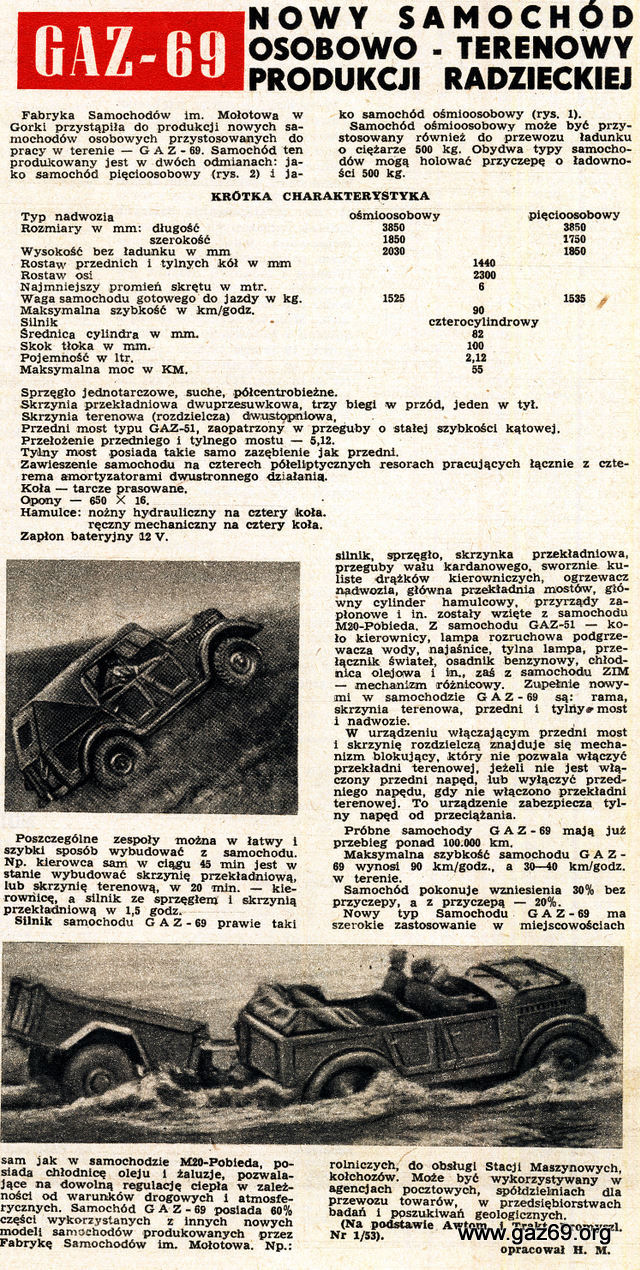
Here is a direct translation of the article from the Polish magazine 'Motor' of early 1953.
GAZ–69
A NEW ALL-TERRAIN RUSSIAN VEHICLE
The eight-passenger version can also be used to carry 500 kg of cargo. Both types can tow a trailer up to 500 kg.
Every major part of the vehicle can be easily removed. For example: within 45 minutes a driver working alone can remove the gearbox, or the transfer box, and removing the engine with the clutch and gearbox will take him only 1.5 hours.
The engine used in the GAZ-69 is almost identical to the one used in GAZ M-20 Pobieda (Victory) passenger car but it is equipped with an oil cooler and a shutter that allow the driver to maintain the engine temperature depending on the weather and driving conditions. GAZ-69 is built using 60% of the parts used in other vehicles built in Gorki. The engine, clutch, gearbox, prop-shaft joints, track rod ends, heater, axles gear, brake master cylinder, the whole ignition system and many more were taken from the GAZ M-20. From the GAZ-51 truck the steering wheel, engine coolant pre-heating torch, head lights, rear light, light switch, fuel filter, oil cooler etc. The differential gear was taken from the ZIM M-12. All new are the chassis, transfer box, front and rear axles, and the body.
Low gear ratio can't be engaged if the front diff is disengaged and the front drive can't be disengaged if the low ratio is still engaged. That prevents the rear axle gear from overloading.
So far the experimental GAZ-69s have covered more than 100.000 km (62.000 miles).
Top speed is 90 km/h (56 mph) and 30-40 km/h (19-25 mph) off road.
The vehicle can climb up a 30% incline and up a 20% incline with a trailer.
The new vehicle can be used widely, in small villages to service local communities, on national farms. It can be also used by the national post and small cooperatives for carrying small cargo and geological research.
The GAZ-69 history video on YouTube.
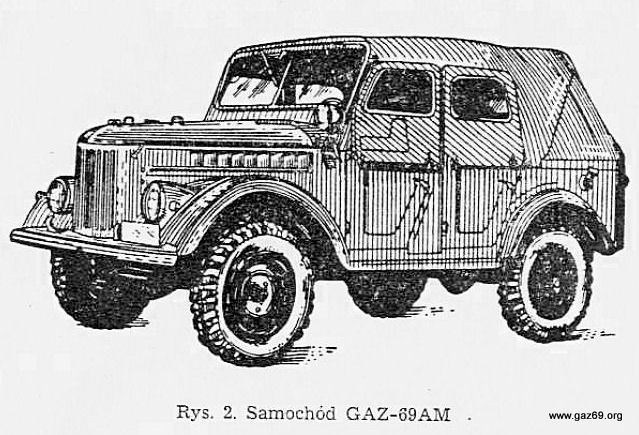
The
factory in Gorki suffered from a lack of space to accommodate the
wide range of their production vehicles, which in the mid-50's
contained M-20 and ZIM M-12 passenger cars, the newly introduced
M-21 Volga and several types of trucks. During 1955 and 1956 (the
process actually started in December 1954) the production of
GAZ-69 was gradually moved into a new factory in Ulianovsk and
the last vehicle was built in Gorky in January 1956. That's when
GAZ 'double personality' life began. Although it carried the new
factory name on the bonnet – UAZ (Ulianovsky Avtomobilny
Zavod), it was still known as GAZ. It stayed like that to the
very end of it's life in 1972. At the turn of 1960's and 1970's
the Russians were trying to export them to Western Europe, still
calling them GAZ-69.
For
some lovely brochures of those on my classic cars website click
this link.
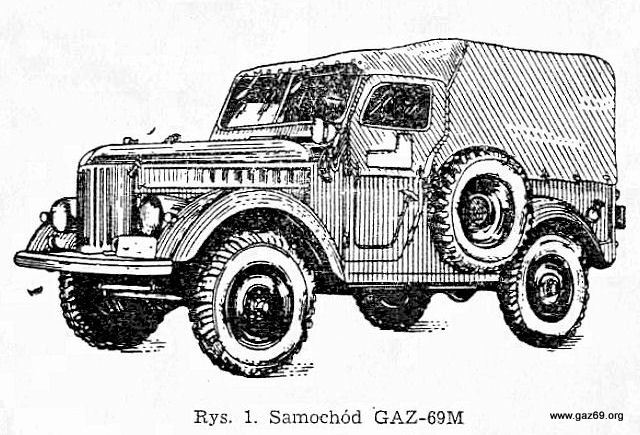
From
the very beginning of his career he gained the nickname 'Kozlik'
– a little male goat.
GAZ-69 was made in two versions:
two-door eight-passenger (or two plus cargo) and four-door five
passenger. Not many changes were made during the production
period. The only improvement was to increase of the engine
capacity from 2.1 to 2.4 litre, which gave it 10 more brake horse
power. Those were designated GAZ-69M and 69AM and built mainly
for export. A few types of carburettors were used and some
vehicles had the ignition system shielded against radio
interference (GAZ-69E). Before 1970 there was only one rear
window in the canvas top, then two additional windows appeared on
each side. This version called GAZ 69-68 had also front
free-wheel hubs and stronger axles.
Leaf spring suspension
with arm-type shock absorbers, side-valve underpowered engine, three-speed gearbox and
manually adjustable drum brakes stayed on till the end of the
production.
Interestingly GAZ-69 never had factory-fitted
outside mirrors. That's why they are different on almost every
vehicle. As far as I know the company never made any hard-tops.
Those we can see today are all 'aftermarket' or DIY built.

There
were several interesting vehicles based on the GAZ 69. Probably
the first one was 1952 GAZ-46
MAV.
It was an amphibious army vehicle inspired by American Ford GPA.
Another one was the GAZ-72 built
from 1955 to 1958 in Gorki. An ancestor to all modern comfortable
cross-terrains, this car combined the chassis of the 69 and the
body of the M-20 Pobieda. 4.677 were made.
GAZ 19 with an
estate type hard top body had two windows on each side and
two-wheel drive. It was built for use by the post office, but it
remained a prototype only.
There were also many other
modifications built for special duties: radio station, fire
engine, street sweeper, crane, anti-tank rocket gun and even a
police car with a hard top and built in prison cell, etc.
For
pictures of all those versions look at this Russian
website.

UAZ
also developed some interesting vehicles based on the GAZ-69. The van
UAZ-450, the ambulance UAZ-450A and the pick-up truck UAZ-450D.
They had the same engines, chassis and suspensions as the 69,
just the bodies were different obviously inspired by the Jeep
Forward Control. The van had 750 kg of load capacity. The
ambulance could accommodate four stretchers or six seating
patients, two paramedics and a driver. The truck could carry up
to 800 kg of cargo. Different wheels (8.40x15 vs. 6.5x16) were
also used.
They went into production in 1958, four years
before the first Land Rover Forward Control.
Modified in 1961 UAZ-461 these models are still built by the UAZ factory today!
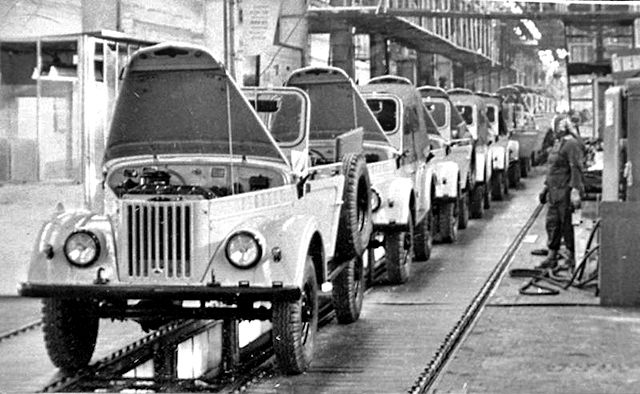
In 1960 the Ulyanowsk factory introduced a belt-system asembly line allowing increase of the production and becoming the most modern factory in the Soviet Union.
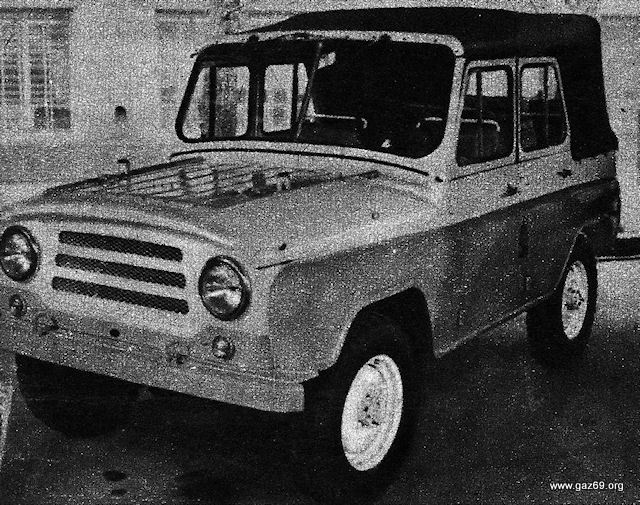
In 1962 UAZ introduced an entirely new model called UAZ-460 with overhead-valve 70 b.h.p. engine and modern four-door, five-passenger, soft-top body. In an article glorifying the achievements of the Soviet motor industry, Polish magazine 'Motor' stated that this vehicle was already in production, along with vans, ambulances and pick-ups! It wasn't. It took another ten years before the vehicle got onto the assembly line. Why? You have to understand how the Russian economy worked in those days. The whole motor industry was managed by the ministry of industry and the factory needed permission and funds from them. The authorities were more focused on developing trucks and lorries needed for the economy. The old 69 had to carry on with his duties for another decade.
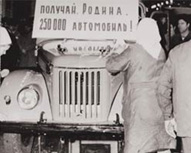
A tiny photo from the official Ulyanovsk factory site. The 250,000th vehicle was produced in 1965.
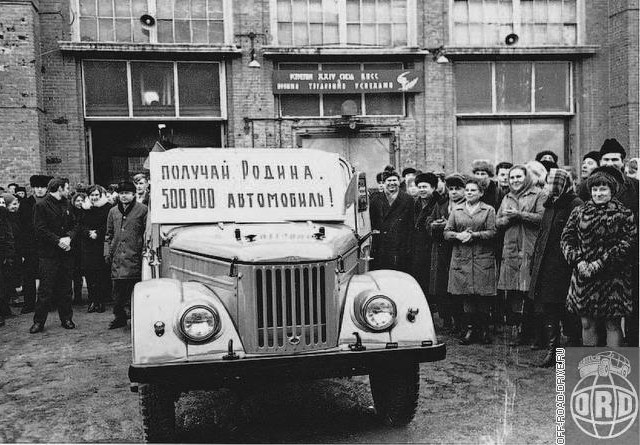
A photograph taken in Ulianovsk probably around 1969-70. Half millionth GAZ/UAZ 69 is leaving the factory.
Many thanks to Matteo Iannizzotto for this picture.

In January 1972 the GAZ 69 finally retired. The last 275 trucks left the factory in Ulianovsk. The new model gained the 'green light' and after ten years of development was put into production as UAZ-469. Relatively modern but simple, with 2.4 litre, overhead-valve engine it quickly become even more popular then it's predecessor. But this is another story...
Total
production:
634,285 examples of all modifications
UAZ/GAZ-69
– 356,624
UAZ/GAZ-69A – 230,185
UAZ/GAZ-69AM
and 69M – 10,551

69s
were supplied to all Eastern European armies, exported to 56
countries and were also built in North Korea under licence as
Kaengsaeng-68.
The most famous however is Romanian ARO. They
bought the licence for the truck without the engine and gear box
and decided to use a locally built unit instead. The first model
called IMS 57 was introduced in 1957 and used a 1933 (!) Ford,
four-cylinder, 3260 cc, 50 bhp engine with compression ratio
4.6:1. It differed from the GAZ in many details, having the spare
wheel mounted on the driver side rear corner, small storage
compartments behind the rear wheels with access from outside,
bench type front seat, dashboard located in the middle of the
fascia and lacking of the transfer box. The bodies were made by
hand, by hammering flat steel sheets on wooden blocks.
Great
improvement was made in 1959 by using a completely new
four-cylinder engine derived from pre-war V8 Ford and a new body,
this time made from pressed steel. Although it looked the same as
GAZ 69 with the spare wheel mounted between the driver door and
the rear wheel arch, none of the body parts were exchangeable.
This model called IMS 59 stayed in production until 1964, when
the new M461 was launched. It had a new engine based (copied?) on
the French Saviem with 70 bhp. Even without the transfer box the
new truck had excellent off-road capabilities. There were also
over 80 improvements, including suspension, brakes, chassis,
steering and body. This model is easy distinguishable by having a
one-piece wind screen and rigid door window pillars. 80,233 units
were built till 1975, 58% of which were exported. There were also
diesel powered versions available on some markets.